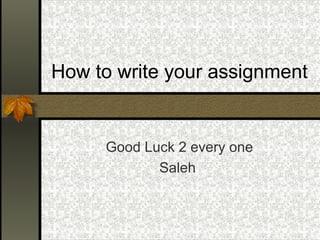
How to write your assignment
- 1. How to write your assignment Good Luck 2 every one Saleh
- 2. How to structure an essay Introduction: What is the essay about? What is its question? How is it structured? Main body: methods of data collection, data analysis, interpretation/discussion or discussion of relevant literature Conclusion: summary, answer to essay question, open questions
- 3. Introduction A “roadmap” to the essay “In this essay, I will discuss…” “This essay looks at/discusses/investigates…” “This essay is structured as follows:…” Key phrases:
- 4. Main body: data analysis Introduce your data: Where did you get them? How do they help you answer the question? Key phrases: Analyse your data: What in particular do you look at and why? What do the data show you with regard to the question? How can you link results to the literature? “If we look at…we can see that…” “The data clearly show that…” “With regard to… it is evident that…”
- 5. Main body: literature review Introduce your sources: What are they? How do they help you answer the question? Key phrases: Discuss your sources: What points are made? How do they relate to each other? Where do you differ or agree? “Author A claims/states/reports/suggests that…” “Author B further develops/opposes/critiques the view that…” “Author C makes a convincing/viable/important point” “Author D’s theory seems debatable/in need of further empirical evidence/is called into question by…”
- 6. Conclusion Sum up the argument: Where did you start out from and what did you find? What’s the answer to the question? What could still be done? Key phrases: “These results suggest that…” “To sum up/in conclusion,…” “Further research into… could show if…”
- 7. Essay style Be explicit State your points explicitly – if you don’t state them clearly the person marking your essay can’t give you credit for them. Be relevant All material should be relevant to the question – irrelevant material will be ignored. Be logical Watch out for logical gaps − do the facts you’re citing really back up the point you’re making?
- 8. Essay style Be clear and concise Avoid long, wordy sentences: don’t ramble! Don’t use ten words when two will do Don’t use a “bookish” word when an everyday word will do E.g. “parsimonious” instead of “scarce” Exception: technical linguistics terminology (e.g. “adjacency pair”, “morpheme”)
- 9. Be clear and concise Two short sentences are better than one long sentence “Prescriptive grammarians have claimed that Standard English is the best form of English and regional dialects should be avoided, but descriptive grammarians don’t believe this, and instead they believe that all different varieties of English have equal value and so from this point of view there is no ‘best’ dialect of English.”
- 10. One idea, one sentence “Prescriptive grammarians have claimed that Standard English is the best form of English and regional dialects should be avoided. But descriptive grammarians don’t believe this. Instead they believe that all different varieties of English have equal value. From this point of view, there is no ‘best’ dialect of English.”
- 11. Backing up what you say Evidence (e.g. examples from a text) Citation / quotation Hedging: “results seem to suggest that…” rather than stating something for a fact
- 12. Paraphrase or plagiarism? To avoid plagiarism, you must give credit whenever you use: another person's idea, opinion, or theory; any fact or information that is not common knowledge; quotations of another person’s actual spoken or written words; or paraphrase of another person’s spoken or written words.
- 13. Key phrases for citing and quoting “X puts the argument as follows: ‘…’” “Y reinforces his/her claim when stating that…” “Following Z, we can say that…”
- 14. Long quotations Long quotations take the form of a separate paragraph with margins adjusted: blah blah blah blah blah blah blah blah blah blah blah blah blah blah blah (author year: page number). Some more of your text here.
- 15. Short references As Smith (2000) has argued, we should not discriminate based on accent. People tend to judge accents based on their preconceptions about the speakers who use that accent (Bloggs 1998: 32-34). It has been found that “people tend to make inferences about the speaker based on his or her accent” (Bloggs 1998: 32). Do not use footnotes for references! Both quotations and paraphrases of a source MUST have a short reference
- 16. References list after your conclusion list all sources in one section list in alphabetical order: Sloan, W. (2003) Title. Publisher. Smith, A. (2004a) Title. Publisher. Smith, A. (2004b) Title. Publisher. Smith, T. (2001) Title. Publisher. web sources: give as much information as available, give exact URLs and access dates list all, and only the sources quoted in the essay
- 17. The most important rules: ALWAYS answer the question! Reference EVERY fact or idea you got from the literature! Structure your essay, its sections and sentences, so as to make it EASY on the reader!
